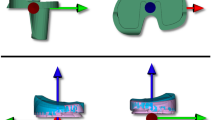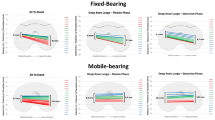Abstract
Background
Posterior-stabilized rotating-platform prostheses for TKAs were designed to improve contact mechanics at the femoral-polyethylene (PE) interface. Short-term followup studies have shown that the PE bearings rotate with respect to the tibia but might not necessarily track with the femur. It is important to know how kinematics in these designs change owing to long-term in vivo use.
Questions/purposes
We asked whether there is a significant change in the in vivo kinematic performance of a posterior-stabilized rotating-platform prosthesis at as much as 10 years postoperative. We specifically examined (1) relative femoral component-PE bearing and relative PE bearing-tibial tray motion; (2) relative AP motion of the femoral condyles with respect to the tibial tray; and (3) relative femorotibial condylar translations.
Methods
In vivo three-dimensional kinematics were evaluated for eight patients at 3 months, 15 months, 5 years, and 10 years after TKA with primary implantation of a posterior-stabilized rotating-platform prosthesis. Each patient performed deep knee bend activity, and three-dimensional kinematics were reconstructed from multiple fluoroscopic images using a three-dimensional to two-dimensional registration technique. Once complete, relative component axial rotation patterns, medial and lateral condyle motions throughout flexion, and the presence of femoral condylar lift-off were analyzed.
Results
Overall, tibial bearing rotation was maintained at 10 years postoperatively. There was no statistical difference between postoperative periods for any kinematic parameter except for femoral component-PE bearing axial rotation, which was reduced at the 10-year evaluation versus other assessment periods (p = 0.0006). The lack of statistical difference between postoperative evaluation periods indicates sustained overall implant kinematic performance.
Conclusions
Our study showed that PE bearing-tibial tray mobility was maintained and that femoral component-PE bearing rotation was reduced at the 10-year followup. This suggests that the overall kinematic performance of this mobile-bearing implant is not negatively affected 10 years postoperatively.
Level of Evidence
Level III, retrospective study. See the Instructions for Authors for a complete description of levels of evidence.





Similar content being viewed by others
References
Argenson JA, Scuderi GR, Komistek RD, Scott WN, Kelly MA, Aubaniac JM. In vivo kinematic evaluation and design considerations related to high flexion in total knee arthroplasty. J Biomech. 2005;38:277–284.
Banks S, Bellemans J, Nozaki H, Whiteside LA, Harman M, Hodge WA. Knee motion during maximum flexion in fixed and mobile-bearing arthroplasties. Clin Orthop Relat Res. 2003;410:131–138.
Buechel FF, Pappas MJ. The New Jersey Low-Contact-Stress Knee Replacement System: biomechanical rationale and review of the first 123 cemented cases. Arch Orthop Trauma Surg. 1986;105:197–204.
Dennis DA, Komistek RD, Mahfouz MR. In vivo fluoroscopic analysis of fixed-bearing total knee replacements. Clin Orthop Relat Res. 2003;410:114–130.
Dennis DA, Komistek RD, Mahfouz MR, Haas BD, Stiehl JB. Multicenter determination of in vivo knee kinematics after total knee arthroplasty. Clin Orthop Relat Res. 2003;416:37–57.
Dennis DA, Komistek RD, Mahfouz MR, Outten JT, Sharma A. Mobile-bearing total knee arthroplasty: do the polyethylene bearings rotate? Clin Orthop Relat Res. 2005;440:88–95.
Dennis DA, Komistek RD, Mahfouz MR, Walker SA, Tucker A. A multicenter analysis of axial femorotibial rotation after total knee arthroplasty. Clin Orthop Relat Res. 2004;428:180–189.
Dennis DA, Komistek RD, Scuderi GR, Zingde S. Factors affecting flexion after total knee arthroplasty. Clin Orthop Relat Res. 2007;464:53–60.
Dennis DA, Komistek RD, Stiehl JB, Walker SA, Dennis KN. Range of motion after total knee arthroplasty: the effect of implant design and weight-bearing conditions. J Arthroplasty. 1998;13:748–752.
D’Lima DD, Chen PC, Colwell CW Jr. Polyethylene contact stress, articular congruity, and knee alignment. Clin Orthop Relat Res. 2001;392:232–238.
Garling EH, Kaptein BL, Nelissen RG, Valstar ER. Limited rotation of the mobile-bearing in a rotating platform total knee prosthesis. J Biomech. 2007;40(suppl 1):S25–30.
Goodfellow J, O’Connor J. The mechanics of the knee and prosthesis design. J Bone Joint Surg Br. 1978;60:358–369.
Hansson U, Toksvig-Larson S, Jorn LP, Ryd L. Mobile vs. fixed meniscal bearing in total knee replacement: a randomised radiostereometric study. Knee. 2005;12:414–418.
Hoff WA, Komistek RD, Dennis DA, Gabriel SM, Walker SA. Three-dimensional determination of femoral-tibial contact positions under in vivo conditions using fluoroscopy. Clin Biomech (Bristol, Avon). 1998;13:455–472.
Komistek RD, Allain J, Anderson DT, Dennis DA, Goutallier D. In vivo kinematics for subjects with and without an anterior cruciate ligament. Clin Orthop Relat Res. 2002;404:315–325.
Komistek RD, Dennis DA, Mahfouz MR. In vivo fluoroscopic analysis of the normal human knee. Clin Orthop Relat Res. 2003;410:69–81.
Komistek RD, Dennis DA, Mahfouz MR, Walker S, Outten J. In vivo polyethylene bearing mobility is maintained in posterior stabilized total knee arthroplasty. Clin Orthop Relat Res. 2004;428:207–213.
Lafortune MA, Cavanagh PR, Sommer HJ 3rd, Kalenak A. Three dimensional kinematics of the human knee during walking. J Biomech. 1992;25:347–357.
Mahfouz MR, Hoff WA, Komistek RD, Dennis DA. A robust method for registration of three-dimensional knee implant models to two-dimensional fluoroscopy images. IEEE Trans Med Imaging. 2003;22:1561–1574.
Ranawat CS, Komistek RD, Rodriguez JA, Dennis DA, Anderle M. In vivo kinematics for fixed and mobile-bearing posterior stabilized knee prostheses. Clin Orthop Relat Res. 2004;418:184–190.
Russo A, Montagna L, Bragonzoni L, Visani A, Marcacci M. Changes in knee motion over the first 3 years with a mobile-bearing prosthesis. Knee. 2006;13:301–306.
Sharma A, Komistek RD. Contact mechanics of the human knee. In Scott WN, ed. Insall & Scott Surgery of the Knee. 5th ed. Philadelphia, PA: Elsevier; 2012:e148–e154.
Sharma A, Komistek RD, Ranawat CS, Dennis DA, Mahfouz MR. In-vivo contact pressures in total knee arthroplasty. J Arthroplasty. 2007;22:404–416.
Sharma A, Komistek RD, Scuderi GR, Cates HE Jr. High-flexion TKA designs: what are their in vivo contact mechanics? Clin Orthop Relat Res. 2007;464:117–126.
Sharma A, Leszko F, Komistek RD, Scuderi GR, Cates HE Jr, Liu F. In vivo patellofemoral forces in high flexion total knee arthroplasty. J Biomech. 2008;4:642–648.
Stiehl JB, Dennis DA, Komistek RD, Crane HS. In vivo determination of condylar lift-off and screw-home in a mobile-bearing total knee arthroplasty. J Arthroplasty. 1999;14:293–299.
Stiehl JB, Dennis DA, Komistek RD, Keblish PA. In vivo kinematic analysis of a mobile bearing total knee prosthesis. Clin Orthop Relat Res. 1997;345:60–66.
Stukenborg-Colsman C, Ostermeier S, Hurschler C, Wirth CJ. Tibiofemoral contact stress after total knee arthroplasty: comparison of fixed and mobile-bearing inlay designs. Acta Orthop Scand. 2002;73:638–646.
Wasielewski RC, Komistek RD, Zingde SM, Sheridan KC, Mahfouz MR. Lack of axial rotation in mobile-bearing knee designs. Clin Orthop Relat Res. 2008;466:2662–2668.
Zingde SM, Leszko F, Sharma A, Mahfouz MR, Komistek RD, Dennis DA. In vivo determination of cam-post engagement in fixed and mobile-bearing TKA. Clin Orthop Relat Res. 2014;472:254–262.
Acknowledgments
We thank Mathew Anderle BS, Center for Musculoskeletal Research, University of Tennessee (Knoxville, TN, USA), for his invaluable help in collecting and analyzing the data.
Author information
Authors and Affiliations
Corresponding author
Additional information
One of the authors (RDK) certifies that he or a member of his immediate family has or may receive payments or benefits during this study period of an amount of USD 100,001 to USD 1,000,000 from DePuy Synthes Inc (Warsaw, IN, USA). One of the authors (DAD) certifies that he or a member of his immediate family has or may receive payments or benefits during this study period of an amount of more than USD 100,001 from DePuy Synthes Inc.
All ICMJE Conflict of Interest Forms for authors and Clinical Orthopaedics and Related Research editors and board members are on file with the publication and can be viewed on request.
Clinical Orthopaedics and Related Research neither advocates nor endorses the use of any treatment, drug, or device. Readers are encouraged to always seek additional information, including FDA-approval status, of any drug or device prior to clinical use.
Each author certifies that his institution approved the human protocols for these previous studies, that all investigations were conducted in conformity with ethical principles of research, and that informed consent for participation was also obtained.
This work was performed at the University of Tennessee, Knoxville, TN, USA.
About this article
Cite this article
LaCour, M.T., Sharma, A., Carr, C.B. et al. Confirmation of Long-term In Vivo Bearing Mobility in Eight Rotating-platform TKAs. Clin Orthop Relat Res 472, 2766–2773 (2014). https://doi.org/10.1007/s11999-014-3642-6
Received:
Accepted:
Published:
Issue Date:
DOI: https://doi.org/10.1007/s11999-014-3642-6




